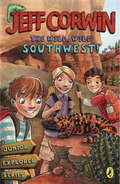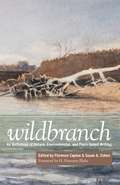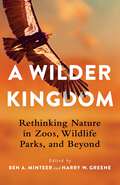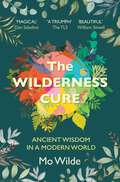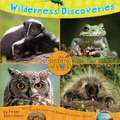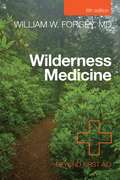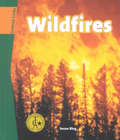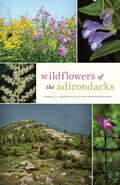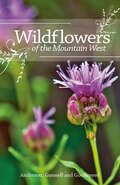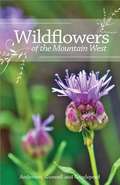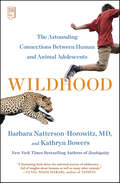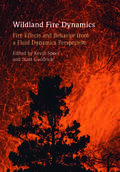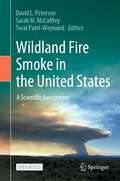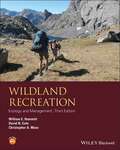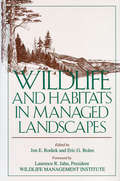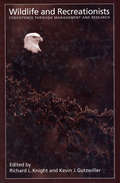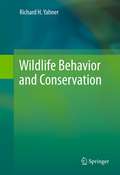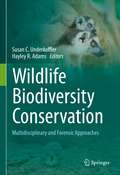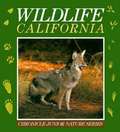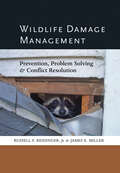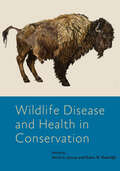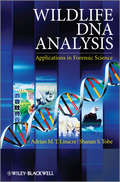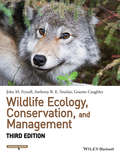- Table View
- List View
The Wild, Wild Southwest!
by Jeff CorwinIt's a fascinating adventure with nature - this time in New Mexico! Budding naturalists Lucy, Benjamin, and Gabe are back and camping in the Gila National Forest in New Mexico! Readers can join the fun as these kids explore the diverse desert ecosystem. This is the third book in Jeff Corwin's young middlegrade fiction series, which shows kids that no matter where you live, you can have fun discovering the plants, animals, and natural life around you. .
Wildbranch: An Anthology Of Nature, Environmental, And Place-based Writing
by Florence Caplow Susan A. CohenWildbranch: An Anthology of Nature, Environmental, and Place-based Writing is a powerful collection of mostly unpublished essays and poetry by both prominent American environmental writers and exciting new voices. The poetry and essays by more than fifty contributors offer the reader glimpses into places as diverse as a forest in West Africa, the moors of Ireland, the canyons of the Sonoran desert mountains, and the fields of New England, and they reflect the varied perspectives of field biologists, hunters, farmers, environmental educators, wilderness guides, academics, writers, and artists. The collection is an intimate portrait of the natural world drawn through the wisdom, ecological consciousness, and open hearts of these exceptional contributors. The Wildbranch Writing Workshop, cosponsored by Orion magazine and Sterling College, has encouraged thoughtful natural history, outdoor, and environmental writing for more than twenty years.
A Wilder Kingdom: Rethinking Nature in Zoos, Wildlife Parks, and Beyond
by Ben A. Minteer and Harry W. GreeneZoos have always had a troubled relationship to what is considered the “real” wild. Even the most immersive and naturalistic zoos, critics maintain, are inherently contrived and inauthentic environments. Zoo animals’ diet, care, and reproduction are under pervasive human control, with natural phenomena like disease and death kept mostly hidden from public view. Furthermore, despite their growing commitment to conservation and education, zoos are entertainment providers that respond to visitors’ expectations and preferences. What would a “wilder” zoo—one that shows the public a wider range of ecological processes—look like? Is it achievable or even desirable? What roles can or should zoos play in encouraging humanity to find meaningful connections with wild animals and places?A Wilder Kingdom is a provocative and reflective examination of the relationship between zoos and the wild. It gathers a premier set of multidisciplinary voices—from animal studies and psychology to evolutionary biology and environmental journalism—to consider the possibilities and challenges of making zoos wilder. In so doing, the contributors offer new insights into the future of the wild beyond zoos and our relationship to wild species and places across the landscape in an increasingly human-dominated era.
The Wilderness Cure
by Mo Wilde'This special and magical book has changed the way I see the world' Dan Saladino'Inspiration and delight sparkle from every page … This book [is] a revelation of joy to the general reader for whom wild food is another country'John Wright, author of the River Cottage handbooks A captivating and lyrical journey into our ancestral past, through what and how we eat.Mo Wilde made a quiet but radical pledge: to live only off free, foraged food for an entire year. In a world disconnected from its roots, eating wild food is both culinary and healing, social and political. Ultimately, it is an act of love and community. Using her expert knowledge of botany and mycology, Mo follows the seasons to find nutritious food from hundreds of species of plants, fungi and seaweeds, and in the process learns not just how to survive, but how to thrive. Nourishing her body and mind deepens her connection with the earth – a connection that we have become estranged from but which we all, deep down, hunger for.This hunger is about much more than food. It is about accepting and understanding our place in a natural network that is both staggeringly complex and beautifully simple. THE WILDERNESS CURE is a diary of a wild experiment; a timely and inspiring memoir which explores a deeper relationship between humans and nature, and reminds us of the important lost lessons from our past.
Wilderness Discoveries
by Peter SchriemerThese two titles have content based upon and supplementing the lessons about God’s creation that are found on the Nature of God DVD collection by Peter Schriemer. These titles, with facts and photos of Hawaii and the Great Lakes habitats and creatures will enrich the lessons taught by Schriemer or can stand alone as informational and fun resources for young readers and their families. The addition of the DVDs showing clips from the Nature of God DVD collections with each book is sure to be a draw for families that are looking for ways to enrich their children’s knowledge of science and nature as well as show, in a beautiful and visual way, that nature is a wonderful gift from God. A quote: Peter Schriemer focuses on a particular ecosystem in the eco-region, how it is designed to sustain life, what amazing creatures and plants live there, and how the science of the creatures and the habitat show evidence of a creator.
Wilderness Medicine: Beyond First Aid (6th Edition)
by William W. ForgeyWith Dr. William Forgey's comprehensive Wilderness Medicine: Beyond First Aid in hand, you can recognize, assess, and treat many kinds of medical emergencies. This fully revised and updated, illustrated text is essential reading for anyone from trip leaders, guides, and search and rescue groups to EMTs, paramedics, and physicians who must provide immediate care when access to a medical facility is difficult or impossible. Learn how to survey, assess, and stabilize the victim and the medical situation, what questions to ask to gain necessary vital information, how to manage physical symptoms as well as care for wounds and orthopedic injuries and much more.
Wildfires (Discovery Links: Set A)
by Susan RingIn the forest, walls of flames, some 100 feet high, tear across the land, burning acres and acres of land. How can this wildfire be stopped? Find out how smoke jumpers and hot shot crews battle these fires, learn what causes them, and discover how fires are a natural part of some ecosystems.
The Wildfires of 2000
by Lisa MoranIn 2000, wildfires swept across much of the West. Cities and towns in Colorado, New Mexico, and Montana were all hit. How do organizations help people recover from wildfires?
Wildflowers of the Adirondacks
by Donald J. Leopold Lytton John MusselmanThe definitive field guide to the magnificent wildflowers of the Adirondacks.Covering more than six million acres of protected wilderness, the Adirondacks, with their landscape of high peaks, verdant wetlands, majestic trees, and lush carpets of flowers, is a pristine paradise for nature lovers. The only available identification guide to the Adirondack region's wildflowers, this comprehensive resource is packed with more than 300 gorgeous color images, one to represent almost every flower commonly found in this huge range. Revealing the stunning diversity of Adirondack wildflowers, from goldenrod and marsh blue violet to cattails and hellebore, the book includes • detailed botanical species accounts, arranged by flower color• images of each flower that highlight key features for easy ID• information about each species' natural history• descriptions of the region's upland, wetland, and aquatic habitats• a special section on the nearly 40 terrestrial orchid species found in the AdirondacksWritten by Donald J. Leopold and Lytton John Musselman, skilled botanists and the foremost authorities on these plants, this superior quality guide will appeal to residents of and visitors to the Adirondacks and northeastern mountains, including wildlife professionals, citizen scientists, backpackers, campers, photographers, bird watchers, artists, and wild food foragers.
Wildflowers of the Mountain West
by Richard M. Anderson Jerry L. Goodspeed Jay Dee GunnellMany recreational hikers have stopped along the trail to admire a wildflower only to wonder what, exactly, they are looking at. Wildflowers of the Mountain West is a useful field guide that makes flower identification easy for the general outdoor enthusiast. Many available plant guides are too technical or cumbersome for non-specialists to embrace. Covering New Mexico, Colorado, Wyoming, Idaho, Utah, Nevada and Oregon, this book is perfect for the enthusiasts who has little botanical knowledge but would like to know more about the wildflowers they are seeing. Organized by flower color for easy reference, plant records include the common and scientific names, a description of typical characteristics, habitat information and distribution maps, look-alike species, color photographs, and informative commentary. In addition, the book provides a useful introduction to the Mountain West region, along with line drawings to illustrate basic flower parts, shapes, and arrangements; a glossary of common botanical terms; a quick search key; and an index. The book is spiral-bound, making it easy to bring along while hiking, backpacking, or biking, and stunning full color photographs make visual confirmation of flower type simple and straightforward.
Wildflowers of the Mountain West
by Richard M. Anderson Jerry L. Goodspeed Jay Dee GunnellMany recreational hikers have stopped along the trail to admire a wildflower only to wonder what, exactly, they are looking at. Wildflowers of the Mountain West is a useful field guide that makes flower identification easy for the general outdoor enthusiast.Many available plant guides are too technical or cumbersome for non-specialists to embrace. Covering New Mexico, Colorado, Wyoming, Idaho, Utah, Nevada and Oregon, this book is perfect for the enthusiasts who has little botanical knowledge but would like to know more about the wildflowers they are seeing. Organized by flower color for easy reference, plant records include the common and scientific names, a description of typical characteristics, habitat information and distribution maps, look-alike species, color photographs, and informative commentary. In addition, the book provides a useful introduction to the Mountain West region, along with line drawings to illustrate basic flower parts, shapes, and arrangements; a glossary of common botanical terms; a quick search key; and an index.The book is spiral-bound, making it easy to bring along while hiking, backpacking, or biking, and stunning full color photographs make visual confirmation of flower type simple and straightforward.
Wildhood: The Astounding Connections between Human and Animal Adolescents
by Barbara Natterson-Horowitz Kathryn BowersPublishers Weekly Most Anticipated Books of Fall 2019 A New York Times Editor&’s PickPeople Best Books Fall 2019Chicago Tribune 28 Books You Need to Read NowBooklist&’s Top Ten Sci-Tech Books of 2019&“It blew my mind to discover that teenage animals and teenage humans are so similar. Both are naive risk-takers. I loved this book!&”—Temple Grandin, author of Animals Make Us Human and Animals in TranslationA revelatory investigation of human and animal adolescence and young adulthood from the New York Times bestselling authors of Zoobiquity.With Wildhood, Harvard evolutionary biologist Barbara Natterson-Horowitz and award-winning science writer Kathryn Bowers have created an entirely new way of thinking about the crucial, vulnerable, and exhilarating phase of life between childhood and adulthood across the animal kingdom.In their critically acclaimed bestseller, Zoobiquity, the authors revealed the essential connection between human and animal health. In Wildhood, they turn the same eye-opening, species-spanning lens to adolescent young adult life. Traveling around the world and drawing from their latest research, they find that the same four universal challenges are faced by every adolescent human and animal on earth: how to be safe, how to navigate hierarchy; how to court potential mates; and how to feed oneself. Safety. Status. Sex. Self-reliance. How human and animal adolescents and young adults confront the challenges of wildhood shapes their adult destinies.Natterson-Horowitz and Bowers illuminate these core challenges through the lives of four animals in the wild: Ursula, a young king penguin; Shrink, a charismatic hyena; Salt, a matriarchal humpback whale; and Slavc, a roaming European wolf. Through their riveting stories—and those of countless others, from adventurous eagles and rambunctious high schooler to inexperienced orcas and naive young soldiers—readers get a vivid and game-changing portrait of adolescent young adults as a horizontal tribe, sharing behaviors and challenges, setbacks and triumphs.Upending our understanding of everything from risk-taking and anxiety to the origins of privilege and the nature of sexual coercion and consent, Wildhood is a profound and necessary guide to the perilous, thrilling, and universal journey to adulthood on planet earth.
Wildland Fire Dynamics: Fire Effects and Behavior from a Fluid Dynamics Perspective
by Kevin Speer Scott GoodrickWildland fires are among the most complicated environmental phenomena to model. Fire behavior models are commonly used to predict the direction and rate of spread of wildland fires based on fire history, fuel, and environmental conditions; however, more sophisticated computational fluid dynamic models are now being developed. This quantitative analysis of fire as a fluid dynamic phenomenon embedded in a highly turbulent flow is beginning to reveal the combined interactions of the vegetative structure, combustion-driven convective effects, and atmospheric boundary layer processes. This book provides an overview of the developments in modeling wildland fire dynamics and the key dynamical processes involved. Mathematical and dynamical principles are presented, and the complex phenomena that arise in wildland fire are discussed. Providing a state-of-the-art survey, it is a useful reference for scientists, researchers, and graduate students interested in wildland fire behavior from a broad range of fields.
Wildland Fire Smoke in the United States: A Scientific Assessment
by Toral Patel-Weynand David L. Peterson Sarah M. McCaffreyThis open access book synthesizes current information on wildland fire smoke in the United States, providing a scientific foundation for addressing the production of smoke from wildland fires. This will be increasingly critical as smoke exposure and degraded air quality are expected to increase in extent and severity in a warmer climate. Accurate smoke information is a foundation for helping individuals and communities to effectively mitigate potential smoke impacts from wildfires and prescribed fires. The book documents our current understanding of smoke science for (1) primary physical, chemical, and biological issues related to wildfire and prescribed fire, (2) key social issues, including human health and economic impacts, and (3) current and anticipated management and regulatory issues. Each chapter provides a summary of priorities for future research that provide a roadmap for developing scientific information that can improve smoke and fire management over the next decade.
Wildland Recreation
by David N. Cole Christopher A. Monz William E. HammittThe authoritative guide to understanding and managing the ecological impacts of recreational activities in wildlands This third edition provides an updated and thorough examination of the ecological impacts of recreational use on wildlands and the best management practices to employ in places where recreation and preservation of natural conditions are both important - and often conflicting - objectives. Covering the latest research, this edition provides detailed information about the environmental changes that result from recreational use. It describes spatial patterns of impact and trends over time, then explores the factors that determine magnitude of impact, including amount of use, type and behavior of use, and environmental durability. Numerous examples, drawn from parks and recreation areas around the world, give readers insight into why certain areas are more heavily damaged than others, and demonstrate the techniques available to mitigate damage. The book incorporates both the first-hand experience of the authors and an exhaustive review of the world's literature on the subject. Boxes provide quick access to important material, and further resources are referenced in an extensive bibliography. Essential reading for all park and protected area management professionals, this book is also a useful textbook for upper division undergraduate and graduate students on recreation ecology and recreation management courses.
Wildlife and Habitats in Managed Landscapes
by Eric Bolen Jon RodiekAmericans are having an increasing impact on the rural landscape as development further encroaches in former wilderness areas. This disruptive land use is causing a decline in wildlife and wildlife habitats. Wildlife and Habitats in Managed Landscapes presents a new strategy for solving this problem by redefining habitats to include the concept of landscape. Employing this strategy, natural resource managers apply tools of planning, management, and design to entire landscapes to meet the needs of both wildlife and humans.
Wildlife and Recreationists: Coexistence Through Management And Research
by Joanna Burger Daniel J. Decker Richard L. Knight Kevin Gutzwiller H. Ken Cordell Paul KerlingerWildlife and Recreationists defines and clarifies the issues surrounding the conflict between outdoor recreation and the health and well-being of wildlife and ecosystems. Contributors to the volume consider both direct and indirect effects of widlife-recreationist interactions, including: *wildlife responses to disturbance, and the origins of these responses *how specific recreational activities affect diverse types of wildlife *the human dimensions of managing recreationists *the economic importance of outdoor recreation *how wildlife and recreationists might be able to coexist The book is a useful synthesis of what is known concerning wildlife and recreation. More important, it addresses both research needs and management options to minimize conflicts.
Wildlife Behavior and Conservation
by Richard H. YahnerBegins with in-depth coverage of wildlife behavior concepts as they relate to conservation problems. Topics will focus principally on discussion, critique, and development of behavioral concepts, with particular attention given to published studies on various topics in wildlife behavioral concepts as related to conservation and natural history. He will include an extensive list of references.
Wildlife Biodiversity Conservation: Multidisciplinary and Forensic Approaches
by Susan C. Underkoffler Hayley R. AdamsThis book addresses the multidisciplinary challenges in biodiversity conservation with a focus on wildlife crime and how forensic tools can be applied to protect species and preserve ecosystems. Illustrated by numerous case studies covering different geographical regions and species the book introduces to the fundamentals of biodiversity conflicts, outlines the unique challenges of wildlife crime scenes and reviews latest techniques in environmental forensics, such as DNA metagenomics. In addition, the volume explores the socio-economic perspective of biodiversity protection and provides an overview of national and international conservation laws. The field of conservation medicine stresses the importance of recognizing that human health, animal health, and ecosystem health are inextricably interdependent and the book serves as important contribution towards achieving the UN Sustainable Developmental Goals, in particular SDG 15, Life on Land. The book addresses graduate students, scientists and veterinary professionals working in wildlife research and conservation biology.
Wildlife California
by Jill BrubakerThe book is a nature guide focusing on the mammals, reptiles, and birds that are found in the wilderness areas of California.
Wildlife Damage Management: Prevention, Problem Solving, and Conflict Resolution
by Russell F. Reidinger Jr. James E. MillerA complete guide to preventing and resolving problems associated with wildlife-human interactions.Whether you are a student in a wildlife degree program or a professional wildlife biologist, you will find all the up-to-date information on wildlife damage in the pages of this clear, comprehensive text. Wildlife Damage Management covers every imaginable topic including:• pertinent biological and ecological concepts• individual-, population-, and ecosystem-level effects• survey techniques• management methods• human dimensions• economic issues• legal and political aspects• damage management strategiesAuthors Russell F. Reidinger, Jr., and James E. Miller explain the evolution of wildlife damage management, differentiate facts from myths, and detail the principles and techniques a professional biologist needs to know. The book discusses native as well as exotic invasive species, zoonotic diseases, hazards to endangered or threatened fauna and flora, and damage to crops, livestock, and property. Reidinger and Miller argue that, in recent years, the rate of undesirable human-wildlife interactions has risen in many areas, owing in part to the expansion of residences into places formerly wild or agricultural, making wildlife damage management even more relevant.From suburban deer eating gardens and shrubs, to mountain lions threatening pets and people, to accidentally introduced species outcompeting native species, Reidinger and Miller show how proper management can reduce wildlife damage to an acceptable, cost-effective level. An extensive section on available resources, a glossary that explains terms and concepts, and detailed figures will aid both students and seasoned professionals. Instructors will find this text arranged perfectly for a semester-long course. The end-of-chapter questions will allow students to ponder the ways wildlife damage management concepts can be put into practice. For those already working in the field—biologists and managers with federal, state, or international agencies—Wildlife Damage Management will serve as an ideal reference book. Destined to set the tone of wildlife damage conversations for the next decade and beyond, Reidinger and Miller belongs on the shelf of all wildlife professionals.
Wildlife Disease and Health in Conservation (Wildlife Management And Conservation Ser.)
by David A. Jessup and Robin W. RadcliffeWildlife DNA Analysis
by Shanan Tobe Adrian LinacreClearly structured throughout, the introduction highlights the different types of crime where these techniques are regularly used. This chapter includes a discussion as to who performs forensic wildlife examinations, the standardisation and validation of methods, and the role of the expert witness in this type of alleged crime. This is followed by a detailed section on the science behind DNA typing including the problems in isolating DNA from trace material and subsequent genetic analysis are also covered. The book then undertakes a comprehensive review of species testing using DNA, including a step-by-step guide to sequence comparisons. A comparison of the different markers used in species testing highlights the criteria for a genetic marker. A full set of case histories illustrates the use of the different markers used. The book details the use of genetic markers to link two or more hairs/feather/leaves/needles to the same individual organism and the software used in population assignment. The problems and possibilities in isolating markers, along with the construction of allele databases are discussed in this chapter. The book concludes with evaluation and reporting of genetic evidence in wildlife forensic science illustrated by examples of witness statements.
Wildlife Ecology And Management
by Eric G. Bolen William Laughlin RobinsonThis exceptionally comprehensive, single-source introduction to the art, science, theories, practices, and issues of wildlife management is ideal for the novice in the subject. Features full-chapters on predators, urban wildlife, policy, water, soil, diseases, conservation biology. New, up-to-date issues covered include the removal of dams, global warming, emerging diseases among elk and deer, adaptive harvest management, animal rights groups, women hunters, population data, migratory animals and more. For anyone interested in an exceptionally comprehensive introduction to wildlife management and conservation.
Wildlife Ecology, Conservation, and Management (Wiley Desktop Editions Ser.)
by John M. Fryxell Anthony R. Sinclair Graeme CaughleyTo understand modern principles of sustainable management and the conservation of wildlife species requires intimate knowledge about demography, animal behavior, and ecosystem dynamics. With emphasis on practical application and quantitative skill development, this book weaves together these disparate elements in a single coherent textbook for senior undergraduate and graduate students. It reviews analytical techniques, explaining the mathematical and statistical principles behind them, and shows how these can be used to formulate realistic objectives within an ecological framework. This third edition is comprehensive and up-to-date, and includes: Brand new chapters that disseminate rapidly developing topics in the field: habitat use and selection; habitat fragmentation, movement, and corridors; population viability. analysis, the consequences of climate change; and evolutionary responses to disturbance A thorough updating of all chapters to present important areas of wildlife research and management with recent developments and examples. A new online study aid – a wide variety of downloadable computer programs in the freeware packages R and Mathcad, available through a companion website. Worked examples enable readers to practice calculations explained in the text and to develop a solid understanding of key statistical procedures and population models commonly used in wildlife ecology and management. The first half of the book provides a solid background in key ecological concepts. The second half uses these concepts to develop a deeper understanding of the principles underlying wildlife management and conservation. Global examples of real-life management situations provide a broad perspective on the international problems of conservation, and detailed case histories demonstrate concepts and quantitative analyses. This third edition is also valuable to professional wildlife managers, park rangers, biological resource managers, and those working in ecotourism.
